Beverly Gray's Blog: Beverly in Movieland, page 118
August 9, 2014
James Shigeta: A Bridge to the Future?
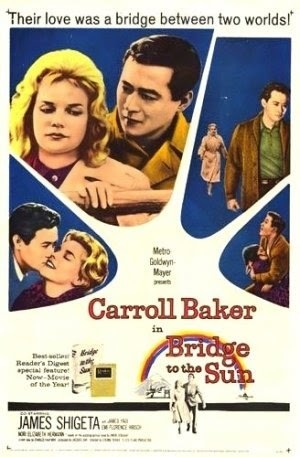
In the back pages of the Los Angeles Times, I just came across a funeral notice for James Shigeta, who probably qualifies as the first Asian-American heartthrob for his roles in two 1961 films, a World War II tearjerker, Bridge to the Sun, and a Rodgers and Hammerstein musical, Flower Drum Song. He passed away on July 28 at the age of 85 after a long, full career that includes a voice role in Mulan and a dramatic death scene in the original Die Hard. The brief item in the Timescontains evidence of a large, loving Japanese-Hawaiian family. I’m sure they will respect his wishes by paying their last respects in aloha attire. And they’ll probably heed the instructions “No okoden.”
I speak Japanese (yes, really!), but this was a new term for me. I found out it refers to the old Japanese custom of mourners bringing cash gifts, enclosed in special paper wrappers, as a form of condolence offering. I always enjoy learning something new, and I also appreciated the chance to think of James Shigeta in a truly Japanese context. He was by birth a third-generation American, one who started out knowing little about the country of his ancestors. Having won first place on Ted Mack’s Original Amateur Hour, he tried to make it as a singer. But even a “European” stage name—Guy Brion—didn’t help him get American bookings. That’s why, after a stint in the U.S. Marine Corps, he went to Japan, learned the language, and became a major musical star. Then Hollywood came calling. His first screen role was as one-third of a romantic triangle in Sam Fuller’s off-beat1959 noir, The Crimson Kimono. For a change, here was an Asian character who spoke standard English and was played by someone of the correct ethnicity. The original ads for this flick play up its shock value. Above a sketch of an embracing couple, we read: “Yes, this is a beautiful American girl in the arms of a Japanese boy!”
After World War II, the moviegoing public seemed newly intrigued by stories about the intermingling of Americans and Asians. I remember the hubbub over Sayonara (1957), a romantic melodrama in which Marlon Brando as a Southern-born Air Force major stationed in Japan, falls hard for the beautiful Miiko Taka. Also in Sayonara, Red Buttons and Miyoshi Umeki won Oscars for playing doomed lovers. Both women’s roles were cast with actual Japanese actresses. But a Japanese male character in the film, Nakamura, is played by none other than Ricardo Montalban.
Prior to Shigeta, most major male Asian roles were undertaken by Caucasians wearing funny makeup. Here are a few that really stand out for me, and not in a good way: Warner Oland, born in Sweden, starring in a long string of Charlie Chan movies. Marlon Brando, playing at being Okinawan, in Teahouse of the August Moon (1956). The protean but very un-Asian Alec Guinness wooing Rosalind Russell in A Majority of One. (In this warm-hearted but ludicrous 1961 comedy, he’s supposed to be Japanese and she’s supposed to be Jewish—oi vey!) Worst of all, a grotesquely buck-toothed Mickey Rooney as a cranky Japanese neighbor in the same year’s Breakfast at Tiffany’s. (Publicists circulated a bogus announcement that the role had gone to a brilliant Japanese comic, Ohayo Arigatou, making his American debut.)
Today things are better. The talented Japan-born Ken Watanabe earned an Oscar nom for 2003’s The Last Samurai. But Asian-American leading men still gripe that their opportunities are limited. Yes, they want to play more than ninjas, superheroes, and sushi chefs.
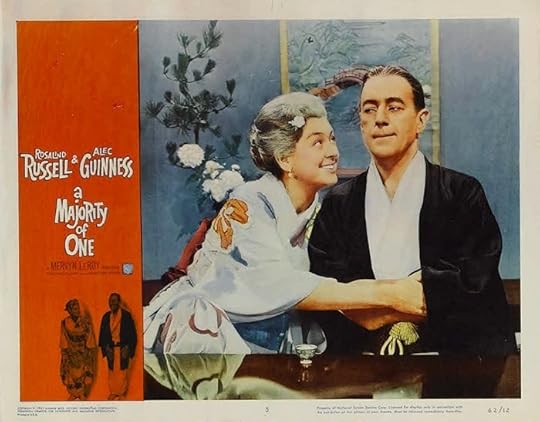
Published on August 09, 2014 23:16
August 8, 2014
Barbra in Old Malibu: Two’s Company
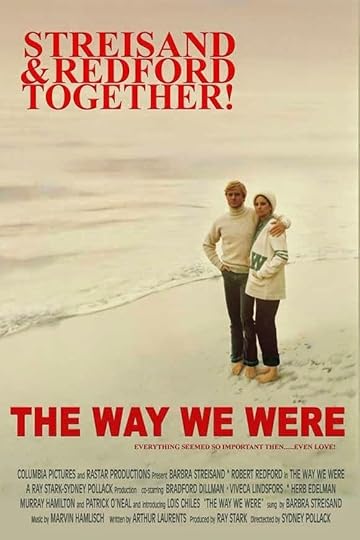
No one is saying there’s reallya Main Street USA.-style row of shoppes in Barbra Streisand’s basement. Michael Tolins’ clever new play, Buyer & Cellar, makes it clear from the start that his premise is total fantasy. But, oh!, we’d like to believe that la Streisand, sequestered in her fabulously decorated Malibu hideaway, longs for one-on-one contact with the new clerk in her private shopping paradise.
That clerk, played by the appealing and hilarious Michael Urie (he was Marc St. James on Ugly Betty), is our guide into Barbra’s world. He begins by showing us an actual coffee-table volume penned by the diva. My Passion for Design (2010) chronicles—through text and Streisand’s own photos—the always-tasteful compound she designed and built as a way of surrounding herself with beauty. Streisand’s meticulous mindset is well known, so it’s not too much of a stretch to imagine her housing her many collections (of dolls, old toys, used costumes, and so on) in quaint boutiques where she can browse and pretend to purchase.
It’s hugely appealing to envision a star of Streisand’s magnitude hanging out, in solitary splendor, in her re-purposed Malibu basement. From the earliest days of Hollywood, we common folk have liked thinking of our celebrities as breathing rarefied air, far from the madding crowds with their workaday lives. In the early years, stars like Mary Pickford chose hilltop aeries, and the trend continues, as any SoCal realtor will tell you. I can’t forget one brouhaha, back in the days when Johnny Depp was still living with Vanessa Paradis and their children. I’d always thought la famille Depp made its home in the south of France, but of course the Beautiful People can’t be limited to only one locale. It seems Depp and company also resided in the Hollywood Hills, overlooking the Sunset Strip. But their happiness was threatened by a planned office tower, far below, that would mar the aesthetics of their 180-degree view of the L.A. basin. It wasn’t that the tower encroached very much: it would be faintly visible only from the Depp children’s expansive play area. Depp was quoted by the L.A. Times as saying that no one had the right to spoil his children’s view. As much as I believe that SoCal overdevelopment needs to be checked, this was one case where I felt no sympathy for a homeowner whose sense of personal entitlement seemed limitless.
Down by the beach, entitlement runs rampant too. Malibu, of course, is a wonderful place for sun, sand, surf, and posh rehab facilities. It’s almost de rigueur for today’s stars to have a beach toehold. Many have put down roots in the Point Dume area, or along the exclusive gated street known as the Malibu Cove Colony. (I’ve been there, thanks to friends in high places, and therefore know what it’s like to truly get away from it all.) Of course, given the rabid nature of some fans, I can respect a celebrity’s need for privacy. But it’s enshrined in California law that beaches are open to everyone. Alas, Malibu-dwellers make quite a game out of limiting public access to their pristine stretch of ocean by way of gates to which only the privileged few have a key.
How curious that stars with down-to-earth appeal like to tuck themselves away in Malibu. I’m thinking not only of Streisand (who was glad to escape the cramped Brooklyn apartment of her childhood) but also the presumably populist Bob Dylan. He may sing of urban environments like Desolation Row, but this particular rolling stone gathers moss near the California surf.
Published on August 08, 2014 14:18
August 5, 2014
James Shigeta: A Bridge to the Future?
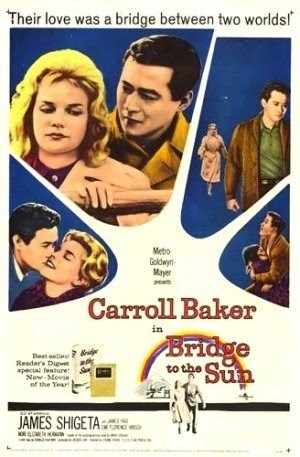 Note the difference in billing!
Note the difference in billing! In the back pages of the Los Angeles Times, I just came across a funeral notice for James Shigeta, who probably qualifies as the first Asian-American heartthrob for his roles in two 1961 films, a World War II tearjerker, Bridge to the Sun, and a Rodgers and Hammerstein musical, Flower Drum Song. He passed away on July 28 at the age of 85 after a long, full career that includes a voice role in Mulan and a dramatic death scene in the original Die Hard. The brief item in the Timescontains evidence of a large, loving Japanese-Hawaiian family. I’m sure they will respect his wishes by paying their last respects in aloha attire. And they’ll probably heed the instructions “No okoden.”
I speak Japanese (yes, really!), but this was a new term for me. I found out it refers to the old Japanese custom of mourners bringing cash gifts, enclosed in special paper wrappers, as a form of condolence offering. I always enjoy learning something new, and I also appreciated the chance to think of James Shigeta in a truly Japanese context. He was by birth a third-generation American, one who started out knowing little about the country of his ancestors. Having won first place on Ted Mack’s Original Amateur Hour, he tried to make it as a singer. But even a “European” stage name—Guy Brion—didn’t help him get American bookings. That’s why, after a stint in the U.S. Marine Corps, he went to Japan, learned the language, and became a major musical star. Then Hollywood came calling. His first screen role was as one-third of a romantic triangle in Sam Fuller’s off-beat1959 noir, The Crimson Kimono. For a change, here was an Asian character who spoke standard English and was played by someone of the correct ethnicity. The original ads for this flick play up its shock value. Above a sketch of an embracing couple, we read: “Yes, this is a beautiful American girl in the arms of a Japanese boy!”
After World War II, the moviegoing public seemed newly intrigued by stories about the intermingling of Americans and Asians. I remember the hubbub over Sayonara (1957), a romantic melodrama in which Marlon Brando as a Southern-born Air Force major stationed in Japan, falls hard for the beautiful Miiko Taka. Also in Sayonara, Red Buttons and Miyoshi Umeki won Oscars for playing doomed lovers. Both women’s roles were cast with actual Japanese actresses. But a Japanese male character in the film, Nakamura, is played by none other than Ricardo Montalban.
Prior to Shigeta, most major male Asian roles were undertaken by Caucasians wearing funny makeup. Here are a few that really stand out for me, and not in a good way: Warner Oland, born in Sweden, starring in a long string of Charlie Chan movies. Marlon Brando, playing at being Okinawan, in Teahouse of the August Moon (1956). The protean but very un-Asian Alec Guinness wooing Rosalind Russell in A Majority of One. (In this warm-hearted but ludicrous 1961 comedy, he’s supposed to be Japanese and she’s supposed to be Jewish—oi vey!) Worst of all, a grotesquely buck-toothed Mickey Rooney as a cranky Japanese neighbor in the same year’s Breakfast at Tiffany’s. (Publicists circulated a bogus announcement that the role had gone to a brilliant Japanese comic, Ohayo Arigatou, making his American debut.)
Today things are better. The talented Japan-born Ken Watanabe earned an Oscar nom for 2003’s The Last Samurai. But Asian-American leading men still gripe that their opportunities are limited. Yes, they want to play more than ninjas, superheroes, and sushi chefs.
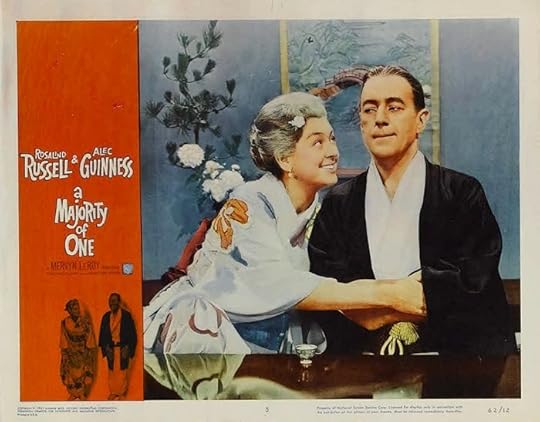
Published on August 05, 2014 09:37
August 1, 2014
Conan (and Corman) vs. Pteracuda

History, as Conan O’Brien will be the first to tell you, is about to be made. As a late-night talk show host he has, by his own admission, achieved “a level of perfection that can’t be equaled.” That’s why he’s decided to shift gears and conquer Hollywood as a dramatic actor. His first role is a head-turning, gut-wrenching cameo in Roger Corman’s latest cheapie, Sharktopus vs. Pteracuda, which will debut August 2 on Syfy, during “Sharknado Week.”
Conan being Conan, he’s playing up the honor for all he’s worth. To tout his own performance in what he calls a “powerful, hyperrealistic film,” he has sprung for a billboard, advertising himself as a candidate for Emmy and Oscar consideration. As he told his studio audience, he’d hoped for a spot on L.A.’s flashy Sunset Strip, where everyone of importance would be sure to see it. Instead, the Conan billboard hovers over “the Historic Brakes and Alignment District,” somewhere in the vicinity of the cement-encased L.A. River. He’s also taken out an expensive full-page ad in the Hollywood Reporter, featuring an earnest photo of himself alongside a quote: “I’ve never worked so hard to meet the dramatic demands of a performance . . . I want this to be my legacy.”
Everyone, it seems, wants to get in on the act. In that same issue of the Hollywood Reporter, one of Hollywood’s directorial legends has placed a congratulatory ad, which reads, “Congratulations, Conan O’Brien! Your work in Sharktopus vs. Pteracuda is, in a word, sublime.” It’s signed “Your friend, Martin Scorsese.” And the media too are getting involved. On the Time Magazine site, commentator Melissa Locker headlines her post, “Conan O’Brien’s Cameo in Sharktopus vs. Pteracuda is Spectacular.”
Needless to say, all this attention to his Sharktopus sequel is music to Roger Corman’s ears. Roger stopped by Late Night with Conan O’Brien this past week to talk up the mayhem that occurs when Sharktopus (half-shark, half-octopus) tangles with Pteracuda (half-pterodactyl, half-barracuda) in a battle of CGI monsters. This current phase of Roger’s long career began back in 2004 when Dinocroc (yup, half-dinosaur, half-crocodile) became a surprise hit at the American Film Market. But the real breakthrough came in March 2010 with Dinoshark, a made-for-TV production that joined Syfy’s Saturday night monster-movie lineup. By the time Dinoshark aired, network execs were already asking for Sharktopus. As invented by my good friend (and longtime Corman assistant) Frances Doel, Sharktopus was genetically engineered by the U.S. Navy for the purpose of combatting Somali pirates. Naturally it runs amok, swallowing up many pretty girls in bikinis, not to mention Roger’s own daughter as a bungee jumper having a very bad day. (Serious fans will also recall Roger’s own cameo, as a beachcomber less interested in a Sharktopus abduction than in a rare coin left lying on the beach when its bikini-clad owner is dragged into the surf.)
Those who’ve worked with Roger over the years praise his fundamentally serious approach to his material, even back when it involved monsters made of rubber and papier-mâché. As late as 2005, he told one journalist, “The worst thing you can do is say, ‘I want to start out and make a campy movie.’” Still, Roger is also known for keeping up with the times. Today, when it’s considered cool to watch (and mock) a really bad movie of the Sharknado ilk, he’s happy to climb on board, even when this means deliberately undercutting his own creations. Which is why that Conan cameo (see below) makes me grimace. Not because it’s yucky, but because Roger definitely knows better.
Published on August 01, 2014 15:17
July 29, 2014
A Cascade of Memories about Movie Palaces
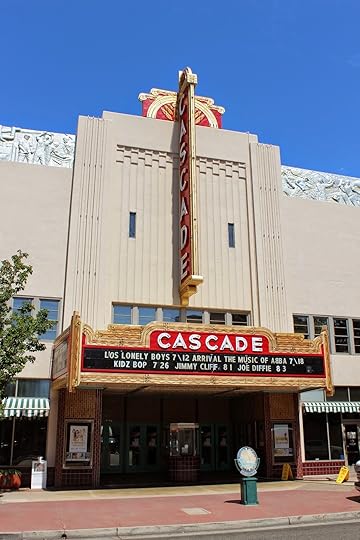
Of course I have fond memories of L.A.’s grand old movie palaces, both those that have survived and those (like the Carthay Circle, once home to Mary Poppins and Around the World in Eighty Days) that have fallen to the wrecking ball. The Los Angeles Conservancy honors this legacy by annually staging “Last Remaining Seats,” a festival of classic films. These screen over a six-week period at such once-opulent Downtown L.A. halls as the Palace, the Million Dollar, and the Orpheum Theatre, which still houses a Mighty Wurlitzer organ.
It’s easy to forget that in the Golden Age of Hollywood every city and township could boast at least one movie palace. Many are gone now, but some – like Albuquerque’s charming KiMo Theatre and Atlanta’s majestic Fox Theatre – have been lovingly preserved and adapted to modern use. (At the Fox, which boasts a kind of Arabian Nights fantasy décor, I once enjoyed a local theatre group’s live-action staging of Oklahoma!)
On a recent driving trip to Portland, Oregon, I caught up with several classic movie palaces that, happily, continue to thrive. One up-and-coming Southeast Portland neighborhood welcomes hipsters to the aptly-named Hollywood Theatre, which was built in 1926 and named to the National Register of History Places in 1983. (Its fancy façade was modeled after Rome’s Baths of Caracalla.) Meanwhile, in tourist-happy Ashland, the Bard is the main draw, but those weary of the delights of the Oregon Shakespeare Festival can catch a flick at the art-deco Varsity Theatre on Main Street.
It was sweltering hot when we passed through Redding, a small city in California’s Sacramento Valley, but I insisted on getting a peek at the Cascade Theatre. Built in 1935, the Cascade was an important part of the Redding scene, partly because it was the first local building to offer air-conditioning. But times change: it was subdivided into four smaller theatres in 1979, then closed its doors in 1997. Seven years later, it rose again, and now enjoys life as a community center and arts venue. My interest in the Cascade stems from a story told me by a Redding native who now teaches college in Southern California. When she was growing up, the Cascade was the only movie house around, and new releases didn’t stay long: “If you didn’t see it the one week it was in town, you didn’t get to see it.”
She came of age in the Vietnam era, when parents and their children rarely agreed on anything. As a student at the local community college, she frequently went to the movies, because “that was sort of my only connection to the outside world.” Her dad, a high-school principal, had become increasingly conservative over the years. When Joe and WUSA (based on Robert Stone’s Hall of Mirrors) were booked at the Cascade in 1970, he spotted an American flag in the ad for the double-feature, and decided to share this patriotic pairing with his daughter. In fact, the films were hardly pro-American, “but my dad, having paid for his admission, insisted on sitting through both movies. . . . I thought he was going to have apoplexy. I really thought he was going to have a heart-attack or something, watching it. He was so enraged, but he wouldn’t leave.” It was one of only two times in her life that they tried movie-going together. Their much later movie outing, to see Saving Private Ryan, doubtless pleased him more.
As motion picture distributors know, you can’t satisfy everyone. But such is the challenge of booking movies – and seeing movies -- in a one-theatre town.
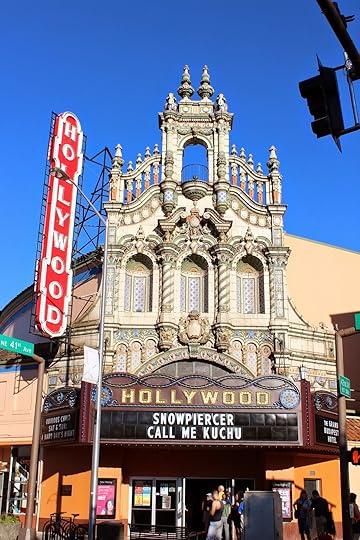
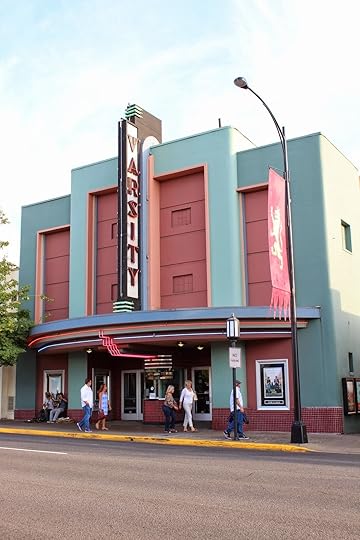 All photos courtesy of Bernie Bienstock
All photos courtesy of Bernie Bienstock
Published on July 29, 2014 15:37
July 25, 2014
There Will Be Blood: The Hatfields and the McCoys
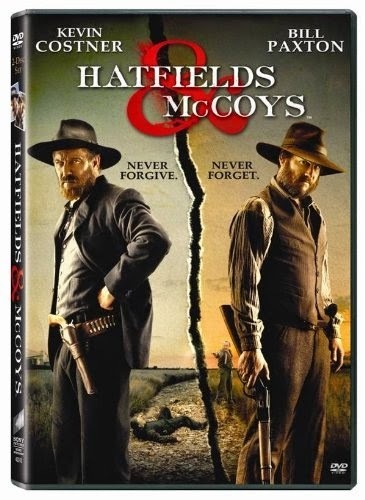
It sometimes feels, in this world of ours, that everyone hates everyone. The newspapers are full of feuds: between Ukraine and Russia, between Sunni and Shia, between Democrat and Republican. Thanks to modern technology, the globe is much smaller than it used to be. That’s why hostilities between factions near the Black Sea can (alas) destroy the lives of innocents from Holland and Malaysia. I guess you can call it progress.
Back in the nineteenth century, feuds may have been equally brutal, but they covered much less territory. Take the famous case of the Hatfields and the McCoys, which played out from 1865 to 1890 in a small valley traversed by the Tug River, separating Kentucky from West Virginia. The long-standing vendetta between these two interrelated mountain families eventually grew so fierce that it nearly reignited the Civil War. Before it petered out, it had captured the imagination of readers across the U.S., thanks to the big-city newsmen who descended on the Tug Valley to get the scoop.
My knowledge of the Hatfields and McCoys does not come from the much-lauded miniseries that ran on the History Channel in 2012. From the looks of the cast list, the producers tried hard to reflect the actual doings of the feud’s main participants. But showbiz understandably needs to cut corners. Anyone wanting the full saga should check out a book that was published in 2013. Dean King’s The Feud: The Hatfields & McCoys: The True Story is the result of years of research, including the author’s discovery of source material that had remained untapped for over a century.
And what a story King tells! It features moonshiners, yellow journalists, bounty hunters, hotheads, deadbeats, crooked lawmen, avengers, turncoats, a Romeo and Juliet romance, kinfolk who die of broken hearts, a public hanging, and the Supreme Court. I learned about the local flora and fauna, and got clued in about the role of razorback hogs (the source of the political term “earmark”) in helping ignite the feud. I also got up to speed on the region’s enthusiastic mating habits: it was not unheard of for a couple like Randall and Sally McCoy to have sixteen children, with the eldest and the youngest born 25 years apart. (Eight of those children would be feud victims.)
Of all the instances of senseless bloodshed, the one that still haunts me took place in 1888. In a New Year’s Day raid, Hatfield marauders attacked a McCoy cabin, killing and maiming several women. Through the long night afterwards, five McCoys huddled around a campfire, watching their home burn to the ground. Writes King, “Sally [McCoy], whose ribs had been broken near the spinal column, was unable to walk, and her bloody hair was frozen to the ground.” Later, he cinematically describes a shootout between a lawman and someone from the Hatfield camp: “Both men squeezed their triggers. Crazy Jim’s hat flew ten feet above his head, like a cap tossed in victory. Some of his brains were inside it.” It’s a story not short of colorful characters (with names like Devil Anse, Hog Floyd, Bad Frank, and Squirrel Huntin’ Sam), but this was no Li’l Abner cartoon. The violence persisted, egged on by bounty seekers and the national press, almost into the twentieth century. Remarkably, in 1913, a later Hatfield, a physican, became a progressive governor of West Virginia. And in 2003, an official peace treaty was signed by the two families’ descendants to symbolize American unity in a post-9/11 world.
I wonder if we’ll need to wait 100 years for today’s international feuds to run their course.
Published on July 25, 2014 11:11
July 22, 2014
Peggy Sue Goes Back to the Future

Last weekend I attended a major reunion of my high school class. I will not divulge how long it’s been since we all graduated from Hamilton High School in West Los Angeles, but there’ve been some serious changes among us: marriages, divorces, births, deaths, expanding waistlines, hair that changed colors or disappeared altogether. Not that my reunion was nearly as eventful as the one portrayed in Francis Ford Coppola’s Peggy Sue Got Married. I don’t think anyone there was time-traveling, and our shindig wasn’t graced by the presence of a one-time dweeb who has now blossomed into a computer zillionaire.
Nonetheless, a good time was had by all. I’ve been to enough reunions to realize that the urge to impress one’s former classmates has long since faded. Instead, we’re all simply grateful that we’re still here, standing on our own two feet (most of us), and happily spinning stories of what we’ve survived and what lessons we’ve learned along the way. Admittedly, my reunion wouldn’t have made for a terribly good movie. The juicy stuff – the diva out to flabbergast, the drunken confessions at the bar, the reuniting of lost lovers who promptly decide to dump their longtime spouses – either didn’t happen or escaped my attention because I was too busy comparing notes about dead parents and favorite teachers. I must say, I didn’t mind at all that the drama of the evening was so muted.
On screen, though, reunions can be potent things. The classic reunion movie, one that remains a touchstone for my generation, is Lawrence Kasdan’s The Big Chill, released in 1983. It’s not about a formal reunion, but rather chronicles a gathering of some Baby Boomers who’d been college chums in the Sixties, and have now gathered fifteen years later to mourn the loss of one of their own. In reviewing The Big Chill for Time Magazine, Richard Corliss wrote, “These Americans are in their 30s today, but back then they were the Now Generation. Right Now: give me peace, give me justice, gimme good lovin'. For them, in the voluptuous bloom of youth, the '60s was a banner you could carry aloft or wrap yourself inside. A verdant anarchy of politics, sex, drugs and style carpeted the landscape. And each impulse was scored to the rollick of the new music: folk, rock, pop, R&B.” Corliss’s description fits my classmates and me as well. We vividly remember the politics of our high school and college days, the loss of JFK, the fear of being drafted, the music by which we lived our lives. One of Saturday night’s highlights for me was the moment the deejay put on the old tunes and some of us bravely bopped to everything from “The Stroll” to “Unchained Melody” to “Honky-Tonk Woman,” in defiance of the passing years.
The Big Chill always puts me in mind of John Sayles’ 1980 indie, The Return of the Secaucus Seven.. Because Sayles broke into movies via the Roger Corman Graduate School of Film, I spoke to him at length while researching my inside bio, Roger Corman: Blood-Sucking Vampires, Flesh-Eating Cockroaches, and Driller Killers. With $40,000 in the bank, the use of someone’s house, and a gaggle of non-SAG actors all turning thirty, Sayles chose to craft a story about former college friends gathering to commemorate the day, ten years earlier, when they all got arrested en route to a D.C. protest march. The film, Sayles’ directorial debut, beautifully fulfills an important Corman maxim: take advantage of what you’ve got.
I’d like to think that my Hami High classmates have done the same.
Published on July 22, 2014 12:30
July 18, 2014
Getting Naked, I’m Afraid
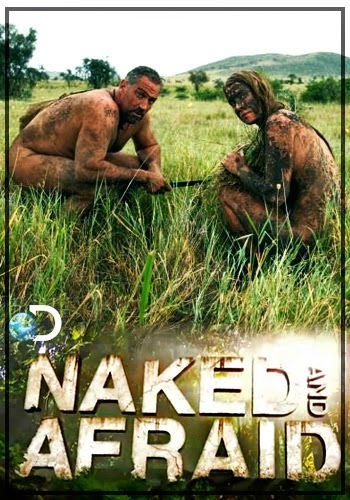
I’m just back from an outdoor wedding in Northern California. Both bride and groom kept their clothes on. This made for a lovely event, but it would have had no cred on today’s reality TV. As I’ve discovered, the new trend is for total nudity. Yesterday, VH1 launched a series called Dating Naked, to compete with such shows as Buying Naked and Naked Vegas.
I stumbled onto the nudity trend via my treadmill TV. Channel-surfing on a Sunday morning, I came across Naked and Afraid, which was launched by the once-dignified Discovery Channel in June 2013. It’s a survivor-type show with a titillating twist: two healthy young Americans of different genders are stranded in some sort of exotic wilderness area, where they must manage to live off the land. For the 21 days of the challenge, they are given no food, no water, and no clothing.
The episode I partly saw, “Mayan Misery,” was set in the jungles of Belize. Cass, a strapping former soldier with a family back home, started out armed with plenty of brute strength. Shannon, a willowy earth-mother type, was touted as an expert on herbs and alternative medicines. Both sported lightweight cross-body satchels containing a diary, a map and one useful item of their own choosing, like a fire-starter or knife. Other than that, they were buck-naked except for their tattoos.
I watched this couple, nearly dying of thirst, risk serious illness by drinking out of local streams. I watched them, faced with torrential rains, crouch in a spooky cave inhabited by bats and who-knows-what. As time passed, I saw the damage done to their skin and bare feet. Basically, they looked like hell. Their nudity (with genitalia discreetly blurred for TV viewers) was hardly a turn-on for me, nor (I presume) for one another. But what was the point, exactly?
In the New York Times for July 17, 2014, Neil Genzlinger published an amusing piece called “Say Yes to Undress,” in which he predicts that someday soon, in deference to “14-year-old viewers and those who wish they still were,” we’ll have All-Bare TV. This trend, he frets, “is going to cost the jobs of countless costume designers, seamstresses, ironers, dry cleaners. Several Emmy Award categories will disappear, though in fairness, one will surely be added for outstanding blurring of crotches and nipples.” He’s not looking forward to Naked Downton Abbey.
My own thoughts have gone in a different direction. Yes, the featured couple in Naked and Afraid is bug-bitten and defenseless, but they’re hardly alone out there in the jungle. This is a TV show, after all. So there’s got to be a camera crew recording their every move. Even with today’s lightweight and versatile equipment, I presume our couple is being tailed 24/7 by a cameraman, a sound recorder, maybe a lighting expert, and likely a producer to keep things running smoothly. None of those folks, I’m guessing, is going without food or water. And I’m quite sure they aren’t required to work in the buff, with their primal parts flapping in the breeze.
Oddly, I’m reminded of How the Grinch Stole Christmas. As I learned when researching Ron Howard: From Mayberry to the Moon . . . and Beyond, the Grinch’s heavy costume and makeup made star Jim Carrey so acutely claustrophobic that one afternoon shooting had to be halted hours earlier than planned. The next day, director Ron Howard showed up in identical Grinch garb out of sympathy for his leading man. Seems only fair that the behind-the-scenes team on Naked and Afraid show some solidarity with their nekkid stars, right?
Published on July 18, 2014 11:37
July 15, 2014
Eli Wallach: Two to Tango
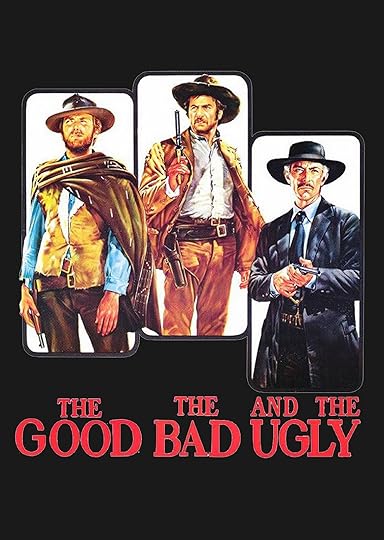 The late Mickey Knox once told me he’d thought of calling his 2004 memoir The Good, the Bad, and the Ugly. This seemed apt, because it was Mickey who – while sojourning in Italy during the blacklist era – adapted the script of Sergio Leone’s classic spaghetti western into American English. But upon learning that his longtime pal Eli Wallach was considering the phrase for the cover of his own upcoming book, Mickey quickly stepped aside. He figured that Wallach had earned the right to borrow the title of Leone’s second Fistful of Dollars follow-up. After all, the movie’s most famous moments involve the scruffy Tuco, the cheerfully malicious and notably “ugly” character played by Wallach with infectious zest. Clint Eastwood may have been the film’s leading man, but it’s Tuco we most fondly remember.
The late Mickey Knox once told me he’d thought of calling his 2004 memoir The Good, the Bad, and the Ugly. This seemed apt, because it was Mickey who – while sojourning in Italy during the blacklist era – adapted the script of Sergio Leone’s classic spaghetti western into American English. But upon learning that his longtime pal Eli Wallach was considering the phrase for the cover of his own upcoming book, Mickey quickly stepped aside. He figured that Wallach had earned the right to borrow the title of Leone’s second Fistful of Dollars follow-up. After all, the movie’s most famous moments involve the scruffy Tuco, the cheerfully malicious and notably “ugly” character played by Wallach with infectious zest. Clint Eastwood may have been the film’s leading man, but it’s Tuco we most fondly remember. Mickey’s book about his oddball career ended up being called The Good, The Bad, and the Dolce Vita: The Adventures of an Actor in Hollywood, Paris, and Rome. Wallach’s own memoir, which came out a year later, bears the puckish title The Good, the Bad, and Me: In My Anecdotage. You can be sure it contains some lively reminiscences about working with Leone. It also covers his other celebrated bandido role, that of the gold-toothed Calvera in 1960’s The Magnificent Seven. There’s no telling why a short Jewish Method Actor from Brooklyn became typecast by Hollywood as a South-of-the-Border outlaw, but Wallach made the two roles his own in a way that the movie industry has never forgotten. Thereafter he was offered a long string of colorful bad-guy parts (thieves, hitmen, Mafia dons) and seemed to relish every one of them.
But despite his lucrative movie career, he continued to return to the New York stage, where he took on roles by Shakespeare, Shaw, Ionesco, Arthur Miller, and his longtime friend, Tennessee Williams. Six years after making his Broadway debut, he won a Tony for Williams’ The Rose Tattoo. He also created the role of Kilroy in Williams’ ambitious Camino Real, thereby missing out on playing Maggio in a hit film, From Here to Eternity. His part went to Frank Sinatra, who won an Oscar.
Wallach was remarkable not only for living long but for living well. By the time he died on June 24 at age 98, he had wracked up 90 film credits. His final feature, Wall Street: Money Never Sleeps, appeared in 2010, when he was a mere 94. A video interview appeared in the New York Times that same year, just prior to Wallach receiving the Motion Picture Academy’s Governors Award “for a lifetime’s worth of indelible screen characters.” The interviewer was Times critic A.O. Scott, who addressed his subject as Uncle Eli for good reason: Scott’s late grandfather was Eli’s older brother. The footage reveals a man who, though aged, is still very much alive. Given how many youngish actors we’ve lost recently – Philip Seymour Hoffman comes to mind – it’s encouraging to see an oldster with a functioning body and an unquenchable spirit.
Not only was the elderly Eli Wallach still capable of being charming. He was also a participant in a love story that lasted sixty-six years. He met Anne Jackson in 1946, when they were cast opposite one another in Tennessee Williams’ This Property is Condemned. They married in 1948, raised three children, and continued to appear in plays together as late as 2000. (Cautioned Jackson, “We're not the couple we play onstage. For us, it's fun to separate the two.")
Long life; long marriage. Who in Hollywood is ever going to be able to equal that record?
Published on July 15, 2014 16:22
July 11, 2014
Up in the Air at the Movies
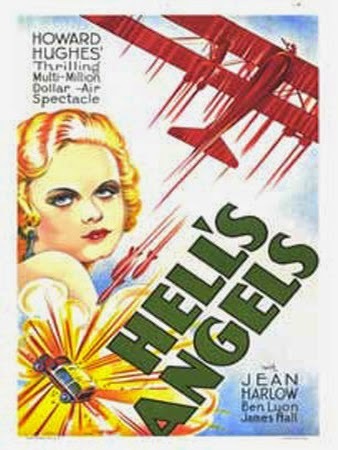
The other night I watched Non-Stop, a 2014 Liam Neeson thriller set aboard a transatlantic flight to London. Moviegoers have flown the unfriendly skies at least since 1954, when washed-up pilot John Wayne fought to save a planeful of passengers in The High and the Mighty. In today’s increasingly precarious world, engine trouble is the least of our worries. Neeson stars as a (yup!) washed-up sky marshal who must fight to save a planeful of passengers from an extortionist who threatens, via text message, to start killing people unless $150 million is deposited into his bank account. And then the mysterious deaths begin.
It’s all very complicated, and more than slightly implausible. But that didn’t stop me from being on the edge of my seat, trying to figure out who aboard the plane – the female lead? the guy with the shaven head? the devout Muslim? the little girl? -- was sending those ominous texts. At the film’s end, after many high-flying emotions, I was very glad to be back on solid ground.
Let’s face it: when it comes to suspense, airplanes and movies just seem to go together. That’s what I was thinking recently when I toured the Museum of Flying, located on the grounds of the Santa Monica Airport. This being Southern California, the museum features aircraft that had co-starring roles in several Hollywood films. Like the sleek little BD-5 micro jet piloted by Roger Moore as James Bond in Octopussy. And the replica of the Wright Brothers’ original Flyer that appeared in Night at the Museum.
In tracing the history of Southern California aviation, the Museum of Flying of course devotes space to a flyboy who went on to make movies of his own. Howard Hughes—inventor, engineer, airline owner, aerospace honcho—also made his mark on Hollywood. In 1930, he produced and co-directed one of his most successful films, Hell’s Angels. This was a rough-and-tumble story of World War I combat pilots, and its aerial dogfight sequences won particular praise. Over seventy years later, Martin Scorsese focused on Hughes’ all-consuming passion for flying in his 2004 biopic, The Aviator.
I also learned the story of Douglas Aircraft, which once occupied the land where the museum now sits. During World War II, the Douglas aircraft plant turned out 300,000 planes for military use. This was such a fantastically large figure that Hitler himself deemed it mere propaganda. But the totals were genuine, thanks to round-the-clock shifts by a legion of dedicated workers, many of them Rosie the Riveters. Yes, at the height of the war, a full 40% of the Douglas workforce was female.
Following Pearl Harbor, company founder Donald Douglas worried that his workplace, located only three miles from the Pacific Ocean, might be vulnerable to Japanese air attack. And so began a little-known collaboration between Hollywood and the aircraft industry. Set builders from Warner Bros. were delegated to create a fake city that completely camouflaged the plant. From the air, busy Douglas Aircraft looked like a collection of houses, buildings, and streets, with nearby runways disguised as farmland.
Today, Hollywood and the airline biz are continuing to merge in curious ways. Recently, flying Delta, I saw a safety featurette that reminded me of the spoofy Airplane. As a chirpy-voiced stewardess described the plane’s features, the camera panned to passengers who were outrageously in dress and behavior. One slithered up the aisle on his belly like a trained seal; another breakdanced into his seat. Demonstrating the oxygen mask was an ALF-like muppet. And who was that giving us the thumbs-up from the cockpit? Yup, Kareem Abdul-Jabbar.
Published on July 11, 2014 10:00
Beverly in Movieland
I write twice weekly, covering topics relating to movies, moviemaking, and growing up Hollywood-adjacent. I believe that movies can change lives, and I'm always happy to hear from readers who'd like t
I write twice weekly, covering topics relating to movies, moviemaking, and growing up Hollywood-adjacent. I believe that movies can change lives, and I'm always happy to hear from readers who'd like to discuss that point.
...more
- Beverly Gray's profile
- 10 followers



